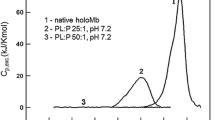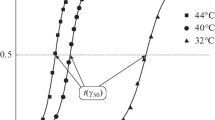Summary
Rates of human red blood cell hemolysis were measured as a function of temperature. Three distinct temperature intervals for hemolysis were noted: a) At temperatures equal to or less than 37°C no hemolysis was observed for the duration of the incubation (30 hr). b) For temperatures exceeding 45°C hemolysis rates are rapid and are accompanied by gross changes in cellular morphology. The activation energy for hemolysis is 80 kcal/mole; this value is characteristic of protein denaturation and enzyme inactivation suggesting that these processes contribute to hemolysis at these high temperatures. c) Between 38 and 45°C the energy of activation is 29 kcal/mole, indicating that a fundamentally different process than protein inactivation is responsible for hemolysis at these relatively low temperatures. A mechanism based on the concept of the critical bilayer assembly temperature of cell membranes (N.L. Gershfeld,Biophys. J. 50:457–461, 1986) accounts for hemolysis at these relatively mild temperatures: The unilamellar state of the membrane is stable at 37°C, but is transformed to a multibilayer when the temperature is raised; hemolysis results because formation of the multibilayer requires exposing lipid-free areas of the erythrocyte surface. An analysis of the activation energy for hemolysis is presented that is consistent with the proposed unilamellar-multibilayer transformation.
Similar content being viewed by others
References
Aniansson, E.A.G., Wall, S.N., Almgren, M., Hoffman, H.H., Kielmann, I., Ulbricht, W., Zana, R., Lang, J., Tondre, C. 1976. Theory of the kinetics of micellar equilibria and quantitative interpretation of chemical relaxation studies of micellar solutions of ionic reactants.J. Phys. Chem. 80:905–922
Chapman, D. 1967. The effect of heat on membranes and membrane constituents.In: Thermobiology. A.H. Rose, editor. p. 123. Academic, London
Drabkin, D.L., Austin, J.H. 1932. Spectrophotometric constants for common hemoglobin derivatives in human, dog, and rabbit blood.J. Biol. Chem. 98:719–733
Eyring, H., Steam, A.E. 1939. The application of the theory of absolute reaction rates to proteins.Chem. Rev. 24:253–270
Gershfeld, N.L. 1986. Phospholipid surface bilayers at the airwater interface. III. Relation between surface bilayer formation and lipid bilayer assembly in cell membranes.Biophys. J. 50:457–461
Gershfeld, N.L., Stevens, W.F., Jr., Nossal, R.J. 1986. Equilibrium studies of phospholipid bilayer assembly; coexistence of surface bilayers and unilamellar vesicles.Faraday Discuss. Chem. Soc. 81:19–28
Gershfeld, N.L., Tajima, K. 1979. Spontaneous formation of lecithin bilayers at the air-water surface.Nature (London) 279:708–709
Ginsberg, L., Gershfeld, N.L. 1985. Phospholipid surface bilayers at the air-water interface. II. Water permeability of dimyristoylphosphatidylcholine surface bilayers.Biophys. J. 47:211–215
Glasstone, S., Laidler, K.J., Eyring, H. 1941. The Theory of Rate Processes. McGraw-Hill, New York
Gottleib, M.H., Eanes, E.D. 1974. On phase transitions in erythrocyte membranes and extracted lipids.Biochim. Biophys. Acta 373:519–522
Ham, T.H., Shen, S.C. Fleming, E.M., Castle, A.B., Castle, W.B. 1948. Studies on the destruction of red blood cells. IV.Blood 3:373–403
Jackson, W.M., Kostyla, J., Nordin, J.H., Brandts, J.F. 1973. Calorimetric study of protein transitions in human erythrocyte ghosts.Biochemistry 12:3662–3667
Karle, H. 1968. Elevated body temperature and the survival of red blood cells.Acta Med. Scand. 183:587–592
Karle, H. 1969. Effect on red cells of a small rise in temperature: in vitro studies.Brit. J. Haematol. 16:409–419
Lamparelli, F., Rosina, R., Petrini-Arisi, C. 1965. Attivita di alcuni enzimi del ciclo glicolitico negli eritrociti sotto posti all'azione del calore.Boll. Soc. Ital. Biol. Sper. 41:1537–1540
LeNeveu, D.M., Rand, R.P., Parsegian, V.A., Gingell, D. 1977. Measurement and modification of forces between lecithin bilayers.Biophys. J. 18:209–230
Marr, A.G., Ingraham, J.L. 1962. Effect of temperature on the composition of fatty acids inEscherichia coli.J. Bacteriol. 84:1260–1267
Martin, J.K., Luthra, M.D., Wells, M.A., Watts, R.P., Hanahan, D.J. 1975. Phospholipase A2 as a probe of phospholipid distribution in erythrocyte membranes. Factors influencing the apparent specificity of the reaction.Biochemistry 14:5400–5408
Phillips, G.B. Dodge, J.T., How, C. 1969. The effect of aging of human red cells in vivo on their fatty acid composition.Lipids 4:544–549
Ponder, E. 1971. Hemolysis and Related Phenomena. Grune and Stratton, New York
Rakow, A.L., Hochmuth, R.M. 1975. Effect of heat treatment on the elasticity of human erythrocytes membranes.Biophys. J. 15:1095–1100
Shen, S.C., Ham, T.H., Fleming, E.M. 1943. Studies on the destruction of red blood cells. III.N. Engl. J. Med. 229:701–713
Tajima, K., Gershfeld, N.L. 1985. Phospholipid surface bilayers at the air-water interface. I. Thermodynamic properties.Biophys. J. 47:203–209
Waugh, R.E. 1987. Effects of inherited membrane abnormalities on the viscoelastic properties of erythrocyte membranes.Biophys. J. 51:363–369
Waugh, R., Evans, E.A. 1979. Thermoelasticity of red blood cell membranes.Biophys. J. 26:115–132
Author information
Authors and Affiliations
Rights and permissions
About this article
Cite this article
Gershfeld, N.L., Murayama, M. Thermal instability of red blood cell membrane bilayers: Temperature dependence of hemolysis. J. Membrain Biol. 101, 67–72 (1988). https://doi.org/10.1007/BF01872821
Received:
Revised:
Issue Date:
DOI: https://doi.org/10.1007/BF01872821




